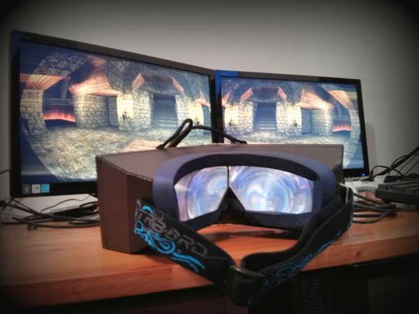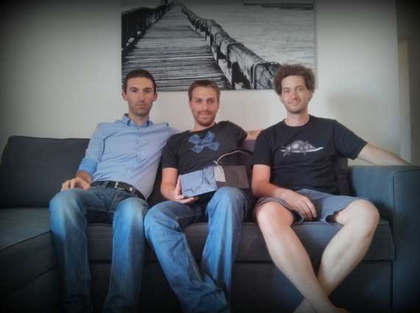![PS4 Oculus Rift concept by T3]()
PS4 Oculus Rift concept by T3
The existence of a virtual reality headset from Sony for their PS4 console has passed well beyond idle speculation over the past 12 months. We bring you new information from a PS4 developer.
Note: This article contains speculation based on information from sources which cannot be officially verified.
Sony, No Stranger to HMDs
![The Sony Glasstron PLM-50]()
The Sony Glasstron PLM-50
Sony have been at the forefront of wearable entertainment technology since the the days of the Walkman and since have pioneered niche products such as the Glasstron and the HMZ line of personal movie viewers. One thing’s for sure, not only do Sony believe in the HMD as a concept, they’ve now amassed years of experience in both miniaturised displays, optics, and ergonomics as a result. If there’s one blue chip company out there that’s best placed to challenge Oculus VR in the immersive VR gaming space, it’s probably Sony.
We’ve been charting the building evidence for Sony’s plans to enter the virtual reality arena for months now. But things started to heat up in the run up to the Gamescom conference last year. Before I headed to the show to cover the event for Road to VR, we received a message from one of our anonymous tipsters saying simply this: “Keep an eye on Sony.” We heeded the advice and watched developments from Sony unfold at Gamescom like hawks but alas, nothing official, just a fresh set of rumours.
Come September, the big media outlets were all spouting the same speculation, this time however there was a level of confidence that doesn’t usually accompany such headlines. Chief among them was Games Industry’s forthright piece entitled “Inside PS4′s new VR headset” in which it stated that there was indeed a headset and that:
![Sony HMZ-T3W]()
Sony HMZ-T3W
The headset (which is not tied to the company’s existing Wearable HDTV Personal 3D Viewer, pictured above) uses the PS4′s PlayStation Eye camera, like Move did, for head tracking. This, say people who have used it, makes the headset even more accurate than the Oculus Rift – though it does present some aesthetic challenges.
At present, the working prototype for the headset, which select developers currently have in house, looks much like Oculus’ better-known VR system – with ping pong balls attached. The design is not expected to be final.
It seemed to us that it wouldn’t be long until we finally had confirmation or perhaps even a reveal by Sony that this seemingly ‘all but confirmed’ headset did indeed exist and when we could expect it. But, things went quiet again, at least unit now.
“Sony’s PS4 VR Headset As Impressive As Valve’s”
![Sony PS4 Camera]()
Sony PS4 Camera
We’ve now received word from someone claiming to not only have tried Sony’s secretive virtual reality hardware but is actively developing software to utilise the device. Our source describes the HMD as having an FOV comparable to that of the Oculus Rift DK1 but with a much higher resolution. Further, the prototype our source had extensive time with, used two glowing orbs mounted atop the headset. Using a camera, assumed at this point to be the standard PS4 stereo camera that launched alongside the console late last year, the system tracks the user’s head in 3D space using the orbs to pinpoint position. Currently we have no information as to how head orientation is tracked, but it would make sense for Sony to include a solution similar to the Oculus Rift headtracker (IMU).
![]()
Sony PS Move Controller
Perhaps more interestingly, though, is that our developer source claims also to have attended the recent Steam Dev Days event in Seattle and sampled Valve’s apparently impressive prototype VR headset. According to the source, the two HMDs compare very favourably. The general impression was that resolution was comparable between Sony’s and Valve’s unit (reported to use two 1080p panels) and that head tracking accuracy was very close.
Finally, the developer also tells us that Sony’s VR headset was supposed to be revealed already but that technical issues delayed the announcement. What those issues were, we do not know.
Wild Speculation
If we hadn’t already made it abundantly clear already, this information is unconfirmed and in no way delivered via official sources. It must all be treated as wild speculation until such time as Sony decides to reveal their plans to enter the virtual reality arena. However, the information does tally with details leaked to other sources and the technology, albeit based on scant details, seems at least technically plausible.
Sony’s Playstation Move was a technically excellent ‘natural input’ controller which suffered horribly from lack of developer support (both first and third party). The ‘Glowing orb’ technology first debuted with this device and a version has found its way into the Dual Shock 4 controller, shipping with every Playstation 4 console. Each active PS4 controller has a glowing strip that faces the player’s screen and camera (if owned), the strip can be used for some reasonably accurate tracking of the controller’s position. Such technology has already been used by the Project Holodeck team to provide tracking references for their prototype HMDs.
Sony’s Playstation Move was a technically excellent ‘natural input’ controller which suffered horribly from lack of developer support (both first and third party).
In all honestly, my concern isn’t the execution of the hardware; Sony has good track records in producing superlative industrial design wrapping innovative technology. My biggest concern is that Sony will use this new device purely as a differentiator in the now ‘current gen’ console race. The PS4 and Xbox One offer such similar experiences, most of which I consider evolutionary—the chance for either to make their system stand out to gamers at large is incredibly valuable.
Whether the PS4 can offer the kind of processing grunt requires to push high resolution, high fidelity, stereoscopic scenes around at frame rates exceeding 60FPS is another question, and perhaps the biggest obstacle to Sony in this venture. As of writing, the AMD based APU in the PS4 offers performance comparable to that of current mid-range PCs—although a single hardware platform affords benefits which inflate its potential—in PC terms the PS4 is already behind the curve in terms of performance. And despite an encouraging trend for games to target a 1080p resolution, frame rates are another matter. Killzone Shadow Fall (PS4, 2013) looks fantastic, but runs at a locked 30FPS, way below the minimum threshold of 60 FPS recommended by Oculus VR Inc for a comfortable VR experience. If PS4 developers are to offer high frame rate, high resolution visuals, it’s clear something’s got to give, and that’s fidelity. Will gamers accept titles sacrificing their cosmetic looks for more immersive delivery?
Sony’s Potential VR Legacy
Here’s the rub though, virtual reality cannot be treated as an add-on or a peripheral. It must be treated as a platform in its own right. Software needs to be conceived, designed, and built from the ground up for the realm of VR, and cannot be tacked onto a renowned franchise as an afterthought. In this respect, Sony’s attempt at VR may well prove damaging to Oculus’ attempt to ensure virtual reality reaches escape velocity. If a company, with as much market reach as Sony, fumbles an entry into VR, it could sour the taste of this revolutionary gaming experience for an entire generation of gamers. And if Sony launch the device before Oculus can come to market, the average Joe may well try this half-hearted, rushed implementation and be put off for another decade.
“…Sony’s attempt at VR may well prove damaging to Oculus’ attempt to ensure virtual reality reaches escape velocity”
This is of course a slightly pessimistic and overly-dramatic scenario, but one that has a very real possibility of coming to pass. Whilst the Games Industry article above does give some encouragement that Sony’s VR venture will not meet the same fate as the PS Move controller, it’s clear the PS4 is a traditional console first and potential platform for virtual reality a very distant second.
As I was writing this article, yet more evidence of the existence of a Sony PS4 VR headset emerged. John Smedley, President of SOE (Sony Online Entertainment), the first party studio behind the likes of the next generation MMO EverQuest Next, appeared to hint at the existence of such a device in a recent Reddit AMAA:
hearing good things about 2 competitors.. one of which actually comes from Sony. so I’m thinking this is real and we may have our Snowcrash after all.
Snow Crash referring to Neal Stephenson’s influential 1992 novel which explores the idea of a virtual reality metaverse.
With any luck John isn’t referring to the dismal HMZ-TQ3, demoed at this year’s CES and was received poorly by those VR enthusiasts that tried it, but to a real dedicated HMD for gamers.
We shall see. As we continue to state, possibly ad-nauseum at this point, 2014 will be a very interesting year for VR.
—
What do you think? Is there now enough speculation and rumour to convince you such an HMD exists? Could Sony do more harm than good by entering the VR arena? Or do you think Sony can bring an important device to the table and help virtual reality enter the public consciousness more quickly? Let us know in the comments below.
Finally, many thanks to our tipster. You know who you are.
The post “Sony’s PS4 VR Headset Is as Impressive as Valve’s” Says Developer—Can Sony Deliver VR That Gamers Deserve? appeared first on Road to Virtual Reality.

































































